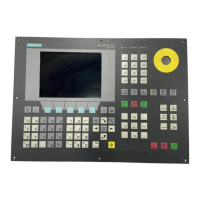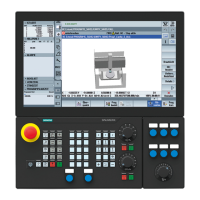W1: Tool offset
18.11 Sum offsets and setup offsets
Basic Functions
Function Manual, 09/2011, 6FC5397-0BP40-2BA0
1571
TOWMCS
Wear data in the MCS (machine coordinate system):
In the case of an active rotation by means of a toolholder with orientation capability:
• The toolholder only rotates the vector of the resultant tool length. Wear is ignored.
Then the tool length vector rotated in this way and the wear are added. The wear is not subjected to the
rotation.
If no toolholder with orientation capability is active or this does not result in a rotation, TOWMCS and TOWSTD are
identical.
Linear transformation
The tool length can be uniquely defined in the MCS only if the MCS is generated by linear transformation from
the BCS.
This would be the case when:
• no kinematic transformation is active
• or orientation transformations (3-axis, 4-axis and 5-axis transformations) are active.
TOWWCS
Wear values in WCS (workpiece coordinate system):
• If a toolholder with orientation capability is active, the tool vector is calculated as for TOWMCS, without taking
the wear into account.
• The wear data are interpreted in the workpiece coordinate system.
The wear vector in the workpiece coordinate system is converted to the machine coordinate system and added to
the tool vector.
TOWBCS
Wear values in BCS (basic coordinate system):
• If a toolholder with orientation capability is active, the tool vector is calculated as for TOWMCS, without taking
the wear into account.
• The wear data are interpreted in the workpiece coordinate system.
The wear vector in the basic coordinate system is converted to the workpiece coordinate system and added to
the tool vector.
Nonlinear transformation
If a nonlinear transformation is active, e.g., with TRANSMIT, and the MCS is specified as the desired coordinate
system, the BCS is automatically used instead of the MCS.
Toolholder with orientation capability
A table component of the toolholder with orientation capability, if available, is not applied directly to the
coordinate systems, unlike a table (or part) component of the kinematic transformation. A rotation described by
such a component is represented in a basic frame or system frame and is thus included in the transition from
WCS to BCS.

